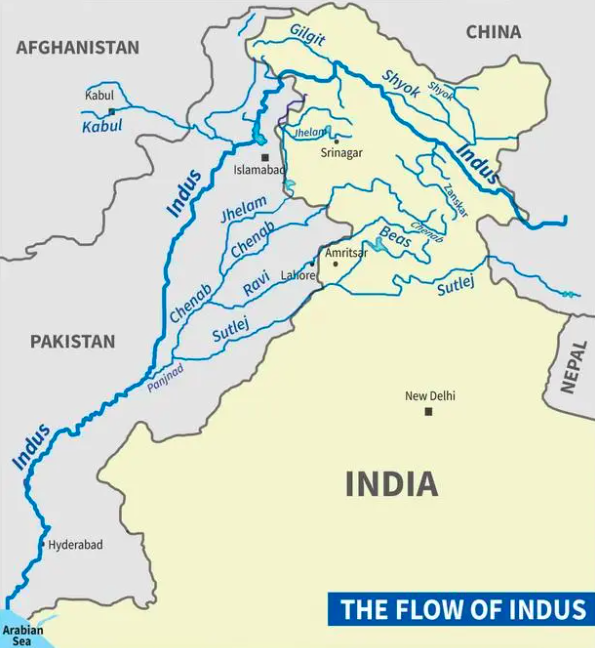SHADOW OVER INDUS WATER TREATY
SHADOW OVER INDUS WATER TREATY
Relevance: GS 2 – Bilateral, regional and global groupings and agreements involving India and/or affecting India’s interests
Why in the news?
- The Indus Waters Treaty (IWT), a long-standing water-sharing agreement between India and Pakistan, has historically survived three wars between the two countries.
- However, the recent Pahalgam terror attack has brought the treaty under severe stress, raising questions about its continued relevance and future viability amid rising tensions.
Background of the Indus Waters Treaty
- Post-partition in 1947, control over the Indus River system became a major issue between India and Pakistan.
- The Indus basin includes six major rivers: Indus, Jhelum, Chenab (largely allocated to Pakistan); Ravi, Beas, Sutlej (largely allocated to India)
- The Indus Waters Treaty was signed in 1960 by Prime Minister Jawaharlal Nehru (India) and President Ayub Khan (Pakistan)
- Brokered by the World Bank, the treaty is seen as a model of international river cooperation.
Significance of the Treaty
- The IWT has governed water sharing peacefully for over six decades.
- It has withstood three wars, various border skirmishes, and prolonged periods of political hostility.
- Despite tensions, it has provided a framework for water stability between two nuclear-armed neighbours.
- Water is essential for human survival, development, and security.
- Transboundary rivers often become sources of tension and conflict, especially when shared by multiple nations.
- The Indus basin is a prime example, supporting the agricultural, economic, and ecological needs of millions in India and Pakistan.
Water Allocation under the Treaty
The IWT divides about 168 billion cubic meters (BCM) of water annually:
- Pakistan receives ~135 BCM (80%) from the western rivers: Indus, Jhelum, and Chenab. India is allowed limited usage for irrigation, navigation, and run-of-the-river hydropower.
- India receives ~33 BCM (20%) from the eastern rivers: Ravi, Beas, and Sutlej, with exclusive rights over their waters.
Institutional Framework
- The treaty established a Permanent Indus Commission (PIC) for Regular dialogue between the two nations and Dispute resolution mechanisms
- The World Bank, as a third-party signatory, plays a role in facilitating arbitration and mediation when required.
IMPORTANCE OF THE INDUS SYSTEM
For Pakistan:
- Supports 90% of agricultural activity.
- Provides water for over 220 million people (~65% of population).
- The Indus Basin Irrigation System, irrigating over 16 million hectares, is the world’s largest contiguous irrigation system.
- Critical for staple crops like wheat, rice, and cotton.
For India:
- Vital to about 120 million people in northern states: Jammu & Kashmir, Himachal Pradesh, Punjab, Haryana, and Rajasthan.
- Supports agriculture, industry, and urban areas.
Emerging Challenges to the Indus Waters Treaty
- The treaty is facing new threats due to strategic, climatic, and political developments.
- Key recent developments include:
- India’s move in early 2023 to seek modification of the treaty.
- The Pahalgam terror attack, which has further strained bilateral relations.
- Water allocation is becoming a flashpoint, especially as both India and Pakistan rely heavily on irrigation for their agrarian economies.
Treaty’s Historical Resilience
- The IWT has survived major conflicts: 1965 War, 1971 War, 1999 Kargil Conflict
- Despite numerous military and diplomatic crises, it has remained a rare functional channel of cooperation and communication between the two nations.
Rising Tensions
- In the 21st century, India’s stance on water-sharing has hardened, influenced by Repeated cross-border terror incidents, Worsening India-Pakistan relations, Revocation of Jammu & Kashmir’s special status by India in 2019
- In early 2023, India:
- Invoked Article XII of the Indus Waters Treaty (IWT)
- Issued a formal notice to Pakistan indicating its intention to seek treaty modifications — a first since the treaty’s signing in 1960
- The move came amid a backdrop of terror attacks such as Uri (2016) and Pulwama (2019)
- The recent Pahalgam attack has further Deteriorated public sentiment in India and Reduced political appetite for continued cooperation under the treaty.
- Indian policymakers argue the IWT is outdated, as it does not reflect:
- Modern hydrological data
- Population pressures
- Climate change impacts
- Evolving water-use patterns and development needs
- India also faces diplomatic and developmental challenges due to:
- Pakistan’s repeated objections to Indian hydropower projects on the western rivers
- Delays and disruptions in India’s infrastructure development in the region
IMPACT ON PAKISTAN
Agricultural Vulnerability
- Agriculture employs nearly 50% of Pakistan’s workforce.
- The sector is heavily reliant on the Indus River system.
- Any disruption or reduction in water flows, especially during key cropping seasons, could severely impact food production, especially wheat and rice
Hydropower and Energy Security
- The Indus system is a vital source of hydropower for Pakistan’s national grid.
- Changes in upstream water regulation by India could affect electricity generation at major dams like Tarbela and Mangla.
- This could lead to increased power outages, economic instability, and energy insecurity.
Environmental and Social Stress
- Reduced river flow may lead to desertification in Sindh and Punjab.
- It would also worsen salinity, soil erosion, and ecosystem degradation in the Indus delta.
- These environmental stresses could trigger internal displacement, particularly among rural communities.
Diplomatic Isolation
- India’s growing global economic and diplomatic clout may tilt international opinion in its favor.
- Pakistan may face challenges in garnering international support or achieving favorable outcomes in dispute resolution.
- With global focus shifting towards broader climate and energy challenges, Pakistan risks losing diplomatic leverage on water-sharing concerns.
IMPACT ON INDIA
Strategic Leverage
- Greater control over western rivers (Indus, Jhelum, Chenab) could:
- Boost irrigation and hydropower capacity
- Support economic growth in northern border states like Jammu & Kashmir, Himachal Pradesh, and Punjab
- Enhance India’s infrastructure and energy security in a strategically sensitive region
International Reputation
- Unilateral modifications or suspension of the IWT may:
- Undermine India’s image as a responsible international actor
- Create diplomatic backlash and international criticism
- Set a negative precedent affecting other transboundary river agreements
Environmental Risks
- Rapid infrastructure development without bilateral coordination may:
- Cause increased sedimentation and disrupt natural river flows
- Damage fragile ecosystems in the Himalayas and Indus delta
- Lead to unintended ecological consequences affecting both nations
THE REPERCUSSIONS
Symbol of Pragmatic Diplomacy
- The Indus Waters Treaty (IWT) is a rare example of sustained cooperation in a conflict-prone region.
- Its success reflects the value of diplomacy in managing shared natural resources.
Geostrategic Sensitivity:
- The Indus basin’s location in a nuclear-armed, densely populated region increases the potential risks of water conflict.
Implications under International Law
- International legal principles emphasize the equitable and reasonable use of shared rivers.
- Suspending or dismantling the IWT could:
- Trigger international legal disputes
- Lead to the militarization of water management
- Set a dangerous precedent for other transboundary river basins in Asia and beyond
Severe Consequences for Pakistan: Pakistan could face major setbacks in Water availability, Food production and security, Energy generation and economic stability.
Risks for India: India’s development trajectory and international image could suffer. May face diplomatic isolation or reputational costs on global platforms
Climate Change Pressures
- Erratic monsoon patterns, glacier retreat, and frequent droughts/floods amplify the need for cooperative water governance
- Joint action is essential for sustainable adaptation and resilience
Human Stakes
- Over 340 million people directly depend on the Indus River system.
- The breakdown of IWT would severely compromise regional water security and coordinated climate response efforts.
Source: https://www.thehindubusinessline.com/opinion/shadow-over-indus-water-treaty/article69487868.ece
Mains Question (250 words):
Discuss the significance of the Indus Waters Treaty in India-Pakistan relations. In light of recent developments, critically analyze the challenges to its continuity and implications for regional stability.




